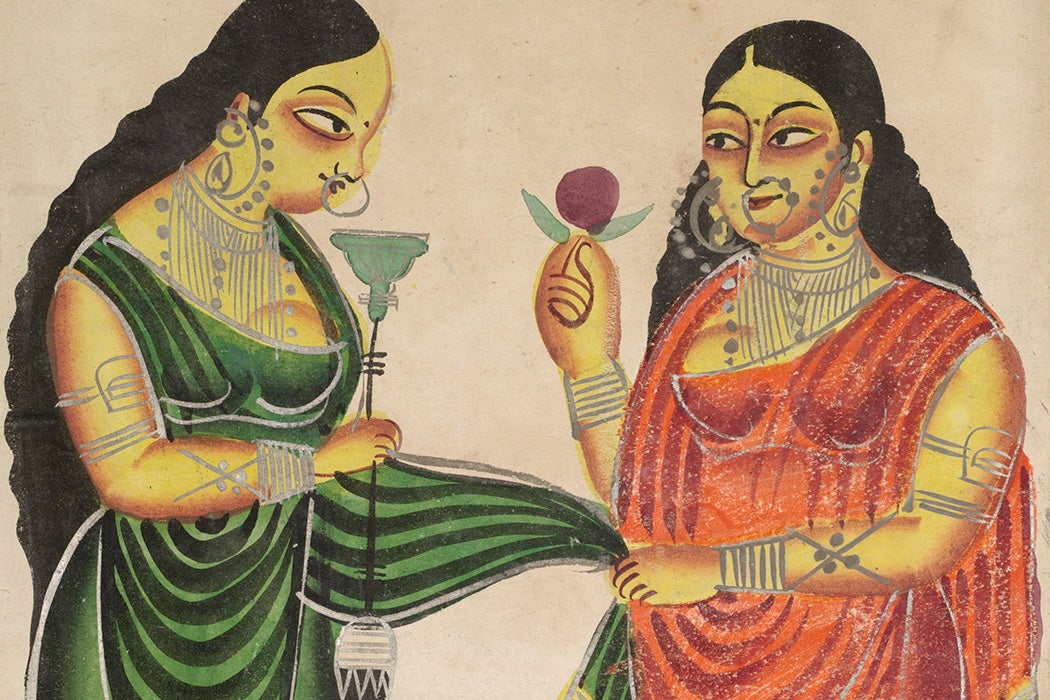As India celebrates the seventy-sixth anniversary of its independence from British rule, colonial practices continue to intersect with nationalist modes of expression. In the late nineteenth century, a compelling example of Indian “tradition” intersecting with Western “modernity” was observed in the colonial sensibility that affected local Bengali artistic practices, widening the gulf between “mass art” available on the market and refined oil paintings gaining popularity under the Calcutta school. The former was created largely by the Kalighat patuas (traditional painters who worked near Calcutta’s Goddess Kali temple at Kalighat) while the latter was created by local artists educated in Western techniques. Despite differences, however, both approaches influenced each other, especially in their depiction of women.
Historian Tapati Guha Thakurta’s 1991 article “Women as ‘Calendar Art’ Icons: Emergence of Pictorial Stereotype in Colonial India” traces the history of “feminine images” that have become the “stock-type of today’s ‘calendar’ pictures.” She relies on early prints—lithographs and oleographs (chromolithographs)—created for mass consumption to reconstruct the perception of the feminine image at the time.
“Gender featured as the central plank in the construction of new ‘icons,’” she writes. “The woman’s image, like the very ideas of womanliness and womanhood, exuded strong ‘iconic’ potentials.” Women’s roles as icons ranged from being seductive and erotic to mythical and religious as they imparted social, political, and ethical values.
The introduction of printing altered the existing imagery of women, which became more “dramatic” as it began to draw inspiration from Western art. Hence, female characters from Indian epics took on European aesthetics while still fitting into the mold of the Indian “feminine divine.” By the late nineteenth and early twentieth century, the clientele of Kalighat art “widened into an undifferentiated mass clientele,” fed by mass-produced picture prints featuring this aesthetic and philosophical fusion.
One sees this in the rising popularity of the art works of Raja Ravi Varma, the famed painter from Travancore who founded India’s largest lithography presses in 1894. Writing of his work, Guha Thakurta notes that the “woman’s image became the main site on which the artist (and his critics) negotiated and reconstructed notions of the ‘mythic’ and ‘sacred’, of ‘tradition’ and a new national ethos.”
Ravi Varma clothed his women in Indian finery and placed them within a mythic narrative, yet they were often inspired by the “nude Venuses and Psyches and their allegorical images of Chastity or Charity” made by Boulanger and Bouguereau, two artists from the French academy. Apart from deification, the feminine figure was also effectively employed to spread a nationalistic message: “rousing her ‘sons’ to patriotic action.”
Weekly Newsletter
According to Guha Thakurta, such depictions made the female image the central figure in both popular and high art. She terms this process as “one of ‘resacralisation,’ where the rise of modernity, instead of separating the secular from the sacred, draws the two into a new synthesis.”
At the same time, these images also portrayed women as sexual objects designed to please the “male gaze” of the artist as well as the audience. Likening Indian mythological paintings to European allegorical ones, she asserts that “the act of male voyeurism was legitimised in these pictures by directly incorporating the erotic experience within the religious and mythological narrative.”
The female figures that weren’t sexualized overtly were portrayed in their roles as middle-class wives and mothers, often captured performing daily household tasks or rituals of personal vanity. Yet these, too, argues historian Chitrita Banerji, fed the hunger of the male gaze.
“The bonti’s uniqueness comes from the posture required to use it: one must either squat on one’s haunches or sit on the floor with one knee raised while the corresponding foot presses down on the base,” she writes.
The knife became “inextricably associated with Bengali women, and the image of a woman seated at her bonti, surrounded by baskets of vegetables [became] a cultural icon.” A fully-clothed cultural icon, but nonetheless, the frequent appearance of the bonti in Khaligat paintings still left scope for viewers to use the images for “erotic stimulation.” As Banerji points out, in case we think we are reading too much into the images, the sexualization of the bonti was soon made obvious with Gurudas Chattopadhyay’s publication of photographs of Calcutta prostitutes working with the knife, offering “a uniquely erotic vision of the female figure, rich in implication and suggestiveness.”







